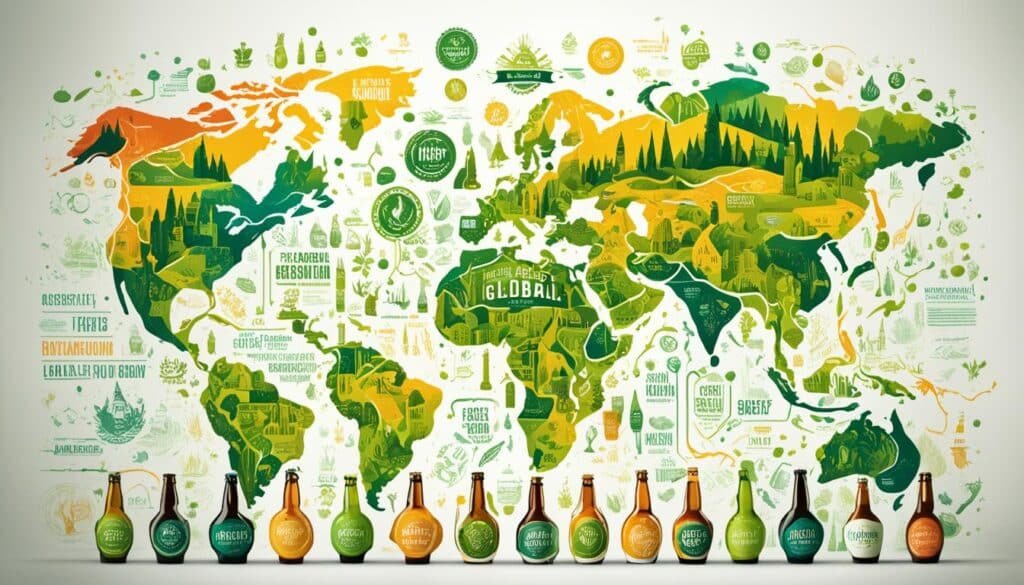In the echelons of global wealth and industry dominion, the race to be crowned the richest brewery in the world is more intense than ever. At the pinnacle of this financial summit sits Anheuser-Busch InBev Sa/NV (NYSE:BUD), with a staggering market cap that underscores its status as a global powerhouse. This brewing behemoth has solidified its reputation by producing a colossal 595 million hectoliters in 2022 alone, capturing over 25% of the globe’s beer production.
Despite facing adversities such as the Bud Light Controversy, which impacted their stock value, Anheuser-Busch InBev SA effortlessly maintains its stature in the wealth rankings, reaffirming its position as the brewery with the highest net worth. Its diversified assortment of beer brands fosters an unrivaled financial value that keeps it firmly rooted at the summit of the brewery sector’s wealth rankings.
Key Takeaways
- Anheuser-Busch InBev SA is a dominant force in the global beer market with significant financial clout and market capitalization.
- Holding over a quarter of global beer production, Anheuser-Busch InBev’s volume speaks volumes about its industry predominance.
- Financial resilience is displayed as it retains the top spot in wealth rankings despite stock market fluctuations.
- The ownership of a vast portfolio of international beer brands contributes to its standing as the richest brewery globally.
- Strategic diversification within the beer industry is key to maintaining financial leadership and market share.
The Craft Beer Revolution and Its Richest Pioneers
The resurgence of interest in artisanal beer, known as the craft beer revolution, has deeply influenced the brewing landscape, tracing its historical roots of beer back to traditional brewing methods. This movement, which began earnestly after homebrewing was legalized in the late 1970s, has sparked not only creativity but substantial economic impact within the industry. In pivoting away from mass-produced beers, these modern brewers have forged a path back to the diverse and robust flavors that characterized the earliest brews.
The Historical Roots of the Craft Beer Industry
The renaissance of craft brewing found its legislative champion in 1978 when President Jimmy Carter legalized homebrewing. This pivotal decision unearthed the historical roots of beer in America, reinvigorating a culture of brewing that predates the industrialization of the process. It harkened back to a time when recipes were passed down through generations and each brew held the unique signature of its maker. The craft beer revolution thus began as a quest for identity and distinction in a market that had been dominated by uniformity.
Top States for Craft Brewery Revenue: California’s Dominance
Among the states that lead the charge in craft brewing, California has emerged as a titan, with its California craft breweries numbering in the hundreds. The state’s rich brewing history, coupled with a culture that values artisanal and locally-sourced products, has paved the way for a fiercely independent brewing scene. This dominance is reflected in the state’s staggering production figures, which propel it to the top of brewery revenue in the U.S.
Notable Craft Breweries Making a Financial Impact
Behind every successful revolution are its leaders, and in the realm of craft beer, the richest breweries are those that have found a way to resonate with beer enthusiasts while also managing lucrative business models. Names like Cigar City Brewing and Rhinegeist Brewery have risen through the ranks, translating their passion for beer into substantial sales volumes. Their success underscores the potential for craft breweries to not only disrupt the status quo but also to claim significant shares of the overall brewery revenue.
As the craft beer revolution continues to ferment, its richest pioneers are charting new territory. With their brews deeply rooted in history, and their eyes set on innovation, these breweries are reshaping the landscape of beer one pint at a time.
Who is the richest brewery?
In the quest to crown the richest brewery, industry titans Anheuser-Busch InBev, Molson Coors, and Constellation Brands often find themselves at the head of the pack. These brewing behemoths extend their reach far beyond the mug, garnering significant financial success and share of the global beer market. Let’s delve into the financial footprints and crafty strategies that not only make them leaders but also contenders for the title of highest earning brewery.
Anheuser-Busch InBev: A Global Giant’s Financial Footprint
When discussing the richest brewery in the world, the conversation inevitably turns to Anheuser-Busch InBev — a powerhouse with unparalleled scale. This global conglomerate has crafted an empire of brews, encompassing a wide array of beer brands and subsidies. Known for producing some of the most popular beers on the planet, Anheuser-Busch InBev’s financial prowess is reflected not just in their sales, but also in their strategic investments and expansions, ensuring their spot as a prevalent candidate for the highest earning brewery.
Molson Coors and Constellation Brands: Crafting Financial Success
Molson Coors Beverage Company (NYSE:TAP) stands tall amongst the brewing elite, having made significant inroads into the craft beer conversation through savvy acquisitions. Jacob Leinenkugel Brewing Company and Blue Moon are prized additions to Molson Coors’s portfolio, contributing notable sales and diversity. Similarly, Constellation Brands (NYSE:STZ), after regrouping from a shaken venture with Ballast Point Brewing, has asserted domination over the Mexican import category within the U.S. market. Its leading labels, Modelo Especial and Corona, continue to drive the organization’s wealth and reinforce its position within the coveted list of richest breweries globally.
| Brand | Owned By | Notable Brands | Market Impact |
|---|---|---|---|
| Anheuser-Busch InBev | Anheuser-Busch InBev | Budweiser, Stella Artois, and many others | Top market share globally; extensive brand portfolio |
| Jacob Leinenkugel Brewing Company | Molson Coors | Leinenkugel’s Summer Shandy | Strong performer in craft beer sector |
| Blue Moon | Molson Coors | Blue Moon Belgian White | Popular craft-style brand with substantial sales |
| Modelo Especial and Corona | Constellation Brands | Modelo Especial, Corona Extra | Leaders in U.S. imported beer category |
Leading Breweries in the Global Beer Market

At the pinnacle of the global beer market, the leading brewery in terms of wealth is undisputedly Anheuser-Busch InBev. With a production volume that eclipses all others and accounts for an impressive quarter of the global beer production, this powerhouse sets the benchmark for financial success in the top-earning brewery industry. The influence of Anheuser-Busch InBev’s wealth on the industry’s landscape is a testament to its unparalleled market position.
Contributing to the dynamism of the top-earning brewery industry are key players like Molson Coors and Constellation Brands. These industry giants have chiseled their marks not just through volume, but through shrewd positioning in niche markets. These markets include the historically rich craft beer sector and brands that resonate with cultural trends, like popular Mexican beer imports.
When evaluating the fiscal acumen within the global beer market, it is essential to highlight the strategic moves that have enabled diverse portfolios, catering to varied consumer preferences. These strategies are a clear indicator of a leading brewery’s wealth and influence. The table below showcases the achievements of these leading breweries that make them behemoths of the industry.
| Brewery | Significant Brand(s) | Market Niche | Global Production (% of Market) |
|---|---|---|---|
| Anheuser-Busch InBev | Budweiser, Stella Artois | Mainstream Global Market | 25% |
| Molson Coors | Blue Moon, Leinenkugel | Craft and Specialty Markets | N/A |
| Constellation Brands | Corona, Modelo Especial | Mexican Beer Imports | N/A |
The table delineates the diversity in portfolio and market niche exploitation that has rendered these breweries as leaders with formidable revenue streams. It is the intricate blend of broad-reaching international brands and specialized acquisitions that secure their status as titans in the top-earning brewery industry. Molson Coors and Constellation Brands have notably expanded their portfolio to include specialty and import categories, reinforcing their wealth within the competitive global tapestry.
Rise of the Breweries: A Story of Mergers, Acquisitions, and Alliances

In the rapidly evolving landscape of the beer industry, mergers and acquisitions have become a notable trend, shaping the future of both global giants and smaller craft entities. This strategic maneuvering often results in significant brewery alliances which foster industry consolidation, allowing major breweries to broaden their horizons and enhance market dominance.
Consolidation in the Industry: Major Players Expand Wealth
The move towards industry consolidation has seen large companies like Molson Coors extend their influence, acquiring esteemed names in the craft beer world. Their strategic acquisitions aren’t solely about adding an artisanal variety to their portfolio; they also manifest the potential for remarkable financial gains.
| Acquired Brand | Parent Company | Dollar Sales (2022) |
|---|---|---|
| Leinenkugel | Molson Coors | $100 million+ |
| Blue Moon | Molson Coors | Not Disclosed |
The Craft Beer Community’s Reception of Big Beer Acquisitions
The craft beer community, known for its dedication to authenticity and independent brewing spirit, often regards the acquisitions by beer conglomerates with a certain level of skepticism. A part of the community fears that these commercial mergers dilute the uniqueness that has been the hallmark of the craft beer scene. Despite contrasting viewpoints within the community, the unified goal remains to celebrate the diversity and creativity inherent in craft beer production.
The Economic Contribution of the Craft Brewing Industry
The craft brewing industry has become a substantial pillar in the economy, with its wide-ranging economic contribution clearly reflecting its importance. By aligning revenue streams with societal benefits such as job creation in brewing and advancing innovation, the industry has cultivated a robust presence in the marketplace. As it continues to develop, the craft brewing industry diversifies economic opportunities and engenders community development.
Revenue Streams and Economic Impact of Craft Breweries
The revenue streams of the craft brewing industry are multi-faceted, with each brewery contributing to the local and national economies through production, sales, and distribution. The Brewers Association underscores this impact by reporting that retail sales of craft beer reached high percentages of the overall beer market revenue. This influx of economic activity drives capital circulation, increases tax contributions and stimulates related sectors such as agriculture, manufacturing, and hospitality.
Fostering Innovation and Job Creation Through Beer
A notable characteristic of the craft brewing industry is its commitment to innovation. The embrace of new brewing techniques, flavor profiles, and sustainable practices not only differentiates the market but also propels advancements across the board. This focus on innovation results in increased job creation in brewing, with significant numbers of individuals finding employment in various roles within the industry. The fostering of talent and skills development is central to sustaining the industry’s growth and competitiveness.
| Year | Craft Beer Market Share | Jobs Supported | Direct Brewery Employment |
|---|---|---|---|
| 2022 | ~24% | 460,000 | 190,000 |
With the craft brewing industry showing no signs of slowing down, its economic contribution through innovative revenue streams and job creation in brewing continues to make a significant and sustainable impact on the economy at large.
Brewing Wealth: The Top-Earning Brewery Brands in the Market
In the competitive landscape of the brewing industry, a few key players have emerged as top-earning breweries, reflective of both their substantial brand value and aggressive strategies for capturing market share. This elite group of brewers has not only achieved financial success domestically but has also made significant inroads on an international level. With carefully curated beer portfolio diversity, these brands have demonstrated an adeptness at understanding and catering to various consumer preferences in multiple markets.
Brand Value and Market Share: A Look at the Wealthy Contenders
Brand value serves as a cornerstone for the top-earning breweries, translating into substantial market share. Anheuser-Busch InBev, known for its strong portfolio, remains an industry powerhouse with iconic brands that appeal to a global audience. Similarly, Molson Coors and Constellation Brands boast impressive brand value, enabling them to secure a significant market share. When it comes to individual success stories, Constellation Brands has leveraged the international acclaim of its Mexican beer imports to perfect its market positioning.
International Expansion and Diversity in Beer Portfolios
International expansion is a defining feature of top-earning breweries as they seek to extend their global footprint. Constellation Brands exemplifies this with a strategic focus on popular Mexican imports such as Modelo Especial and Corona, which have captivated a substantial segment of the U.S. market. The company’s ability to introduce diverse beer selections internationally shows a keen understanding of consumer trends and tastes across different cultures, highlighting the importance of beer portfolio diversity in gaining a competitive edge.
Modelo Especial’s sales soared to $1.02 billion in just a 12-week period, underscoring the potent impact of international expansion on a brewery’s bottom line.
This strategy of expanding beer portfolios to fit a variety of international preferences not only enhances brand presence but also propels revenue growth, solidifying these breweries’ positions as leaders in the market.
Conclusion
The quest to identify the most profitable brewery in the current market leads to a panoramic view of an industry propelled by strategic growth and the brewery financial value. At the zenith of this landscape stands Anheuser-Busch InBev, a colossus whose global footprint outlines the contour of leading brewery wealth. With its multitude of brands and far-reaching influence, it exemplifies the economic prowess that a brewery can attain.
Molson Coors and Constellation Brands have adeptly navigated the waters of the craft beer and Mexican import markets, respectively, amassing considerable financial success. These companies have utilized strategic maneuvers in mergers and acquisitions to solidify their market position and increase their endowment. The craft beer revolution, meanwhile, continues to serve as an influential force in the brewing industry, fostering innovation and contributing a steady stream of revenue and employment opportunities.
As we reflect on the economic contributions and robust mergers characterizing this sector, one can appreciate the immense effort and strategic planning that underpin the success stories of these brewing behemoths. They teach a compelling lesson on the sustainable business models that intertwine product diversity and market savvy with relentless ambition. And it is through this prism that we understand how leading brewery wealth is not a matter of chance but the outcome of an assiduous pursuit of excellence and adaptive strategies in the effervescent world of brewing.
